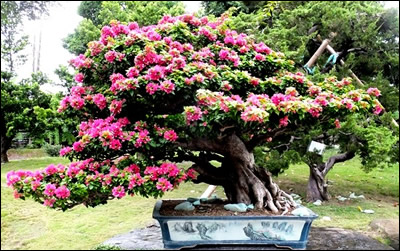BONSAI THROUGH HISTORY
The earliest English observation of potted dwarf trees in China/Macau was recorded in 1637. Travellers included mention of dwarf trees in their accounts of visits to Japan or China. Japanese dwarf trees were seen in the Philadelphia Exposition in 1876, the Paris Expositions of 1878 and 1889, the Chicago Expo of 1893, the St Louis World's Fair of 1904, the 1910 Japan-Britain Exhibition and at the 1915 San Francisco Exposition. The tiny trees were greeted with feelings of astonishment and a sense of awe.
Many who purchased specimens were sorely disappointed when the little trees died. The new owners did not have the knowledge to properly care for them, and their original fascination gave way to the question 'How do you keep them alive?'

The first European language book entirely about Japanese dwarf trees was published in 1902, and the first in English in 1940. Yoshimura and Halfords 'Miniature Trees and Landscapes' was published in 1957. It would become known as the 'Bible of Bonsai in the West', with Yuji Yoshimura being the link between Japanese classical bonsai art and the more progressive Western approach. John Naka, a Japanese American from California, started teaching in California and produced his now famous books on the art.
Over the years, improvements have been made to the revered old bonsai nurseries in Japan, and these have been brought into the Western world by visiting teachers or returning travellers. Early books in European languages leaned towards skills and techniques required for keeping trees alive. At the same time, published material moved towards explaining the aesthetics involved in styling and shaping.
Large permanent collections have been set up in many countries including the U.K. and exhibitions and conventions have become annual events for enthusiasts and the general public. Today, 'bonsai' has become a household word, and there are hundreds of books in multiple languages about bonsai and related arts available worldwide. Small cuttings, bonsai planted in shallow pots, are sold in D.I.Y. stores and garden centres. These are very different from bonsai that are produced by artists in Western countries, as well as Japan.
A very rewarding hobby satisfying so many needs
- An art form
- Horticulture, or the urge to grow things
- Creative to make something beautiful and keep to it looking beautiful
- For ever changing, to view in all seasons
- A sense of the continuance of life, despite all we do to prevent it
- To love and to cherish
